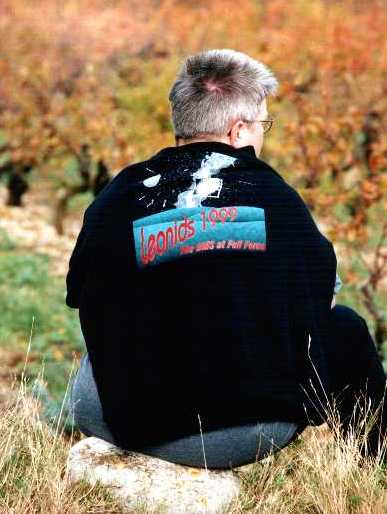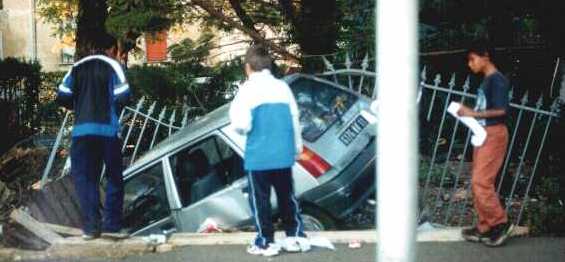|
1. Locations 2. Impressions 3. Images 4. Flooding November 12 & 13 |
Marco Langbroek
(NOTE: basic brief SUMMARY account of facts given in section marked
**********, followed by longer narrative)
Dear All,
We (Marc de Lignie, Casper ter Kuile, Koen Miskotte, Carl Johannink, Elisabeth Middelhoff and me) just returned from our Leonid expedition and want to share a first impression of the incredible meteor display of November 18 (more details (data) will be communicated later). We had to travel 600 km south by car, into Spain, from our initial location near Perpignan in SW France on the day of November 17 because of the weather. But it was worth it!
****************************************************************
At the small village of Xaló, some 80 km south of Valencia, we observed
the most impressive meteor display I ever experienced, under a completely
clear sky. Near 2:00-2:30 UT (Nov. 18), Leonids appeared at an average
rate of some 30-40 per minute, equivalent (very roughly) to a Zenith
Hourly Rate in the order of 4000, given that the radiant was still not
too high in the sky. I suggest this apparition certainly may be called a
true 'storm'. Bright Leonids were conspicuously lacking given the
level of activity (see below).
Due to the Poisson-distribution of meteor rates, we experienced small
bursts in which sometimes 5-6 Leonids appeared at one instance, shooting
away in all directions. The sight was astonishing, and we actually had a
hard time keeping up with counting; this really was at the limit of our
coping abilities.
***************************************************************
Just as Hans Betlem reported for his group (which operated separately from
us), the first hour after rise of the radiant saw little activity. But then
rates boomed spectacularly in a mere 1,5 hours. As rates went up, we first
dropped formal classification procedures and only recorded meteors by
briefly stating their brightness; then we had to stop this too and
started to just indicate a meteor appearance by speaking a short 'yes!'
into the recorder. It became quite surrealistic, this nightly scene of 4
observers simultaniously firing a staccato 'yes, yes, yes-yes, yes,
yes-yes-yes!' into their recorders.
It was amazing, meteors appeared everywhere in the sky in rapid succesion,
and each few minutes I had to take a short break in counting to 'regain
my breath' a little bit. Marvelous! All of us have never been so excited.
One thing that struck us all, was the complete lack of bright Leonids, especially given the high activity level. We did not see any Leonids brighter than -3 to -4, and those only in minute quantities. It reminds me of the 1995 alfa Monocerotids where a similar phenomenon was apparent (see our paper in Astrophysical Journal 479 (1997), 441-447). Yes, this is contra the statement in Hans' mail, but Hans' impression from the video record seems to neglect that a bright video meteor is not a bright visual/photographic meteor, as he pointed out himself at the last DMS meeting.
We have operated a multi-station photographic and video network this night, with a second station some 80 km North of us operated by Robert Haas, Jos Nijland, Romke Schievink, Arnold Tukkers and Rita verhoef. Both stations operated automated platforms with 25 photo-camera's providing coverage of the full sky above 15 degrees altitude, as well as image intensified video cameras. The goal; to obtain accurate orbits of Leonid meteoroids, just as we did in 1995, 1997 and 1998. We expect to have obtained a large number of high accuracy orbits of Leonid meteoroids during the storm with our double station team.
At the end of the night, we all were exhausted; physically and mentally. I personally certainly did experience some effect on my consciousness and functioning; during the peak, my recorder suddenly jammed, causing an unrestrained reaction of panic with me. It took me several minutes just to have my brain realize that it was just a matter of a full tape that had to be replaced. Under these conditions, you just can't think straight anymore, it seems.... These impressive phenomenon really get on you!
Out of a range of celestial phenomenon I've experienced that includes other impressive meteor displays (e.g. 1995 alpha Monocerotids; the 1998 Leonid fireball component from central China), aurora and bright comets, the only thing that in my opinion can match this meteor storm in impressiveness, is a total solar eclipse. Forget about Hale-Bopp etcetera; for me, THIS was THE celestial event of the nineties!
Sincerely,
- Marco Langbroek
Dutch Meteor Society (DMS)

















